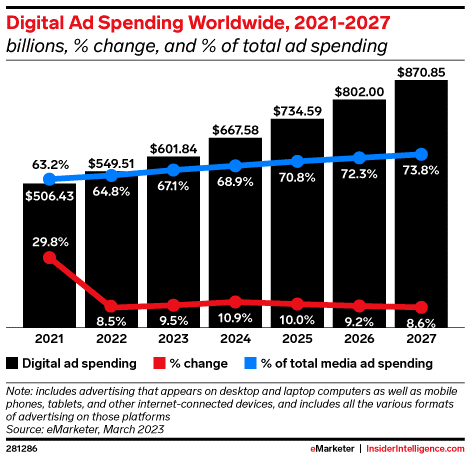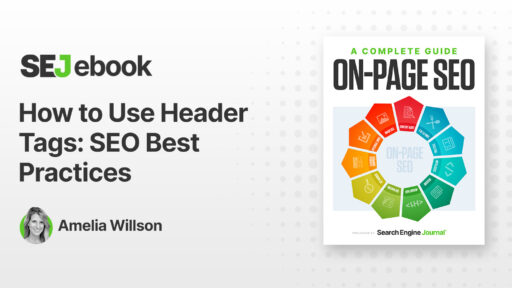Originally Posted on BruceClay – by Bruce Clay

Digital ad spend is set to hit $667 billion in 2024 and will continue to grow over the next few years.

Yet, a large portion of that ad spend will be wasted.
Many businesses want to get their feet wet with PPC ad management before they hire an agency or specialist.
In this article, I’ll cover four ways beginners can succeed in PPC ad management.
- Understand the pros and cons of PPC advertising
- Create ads that speak to your audience
- Take advantage of emerging technologies
- Invest in education
- FAQ: How can I create effective ads for PPC ad management that will help my business succeed?
1. Understand the Pros and Cons of PPC Advertising
PPC can offer quick and measurable results, and it also lets you make changes to your campaigns on the fly.
However, PPC can waste ad spend if not managed correctly, it can be expensive for certain keywords and take a lot of time to manage.
Plus, if you’re not pursuing SEO in tandem, once you stop paying for ads, you disappear from the search results forever.
Takeaways? Invest in help in getting your ad campaigns streamlined and invest in SEO so you can own more of your search traffic in the long run and reduce ad spend at the same time.
2. Create Ads That Speak to Your Audience
It is easy to throw some words on an ad that you think sounds good. It is far harder to get into the minds of your audience and translate that into a compelling ad copy they will click on.
Emerging technologies can help in this area (more on that next), but some basic best practices for ad copy include:
- Focusing on the value you provide to your audience.
- Understanding where they are at in the buying journey.
- Investing time into a great call to action.
These things together will help refine your messaging so it’s more on target.
3. Take Advantage of Emerging Technologies
Machine learning and AI are seeping into every marketing function to offer efficiency, and PPC is no different.
Embracing AI in PPC can offer benefits like ad automation, predicting consumer behaviors, heightened levels of data analysis and creating more effective ad copy.
This translates to making campaigns more impactful. There are a lot of platforms emerging in the space, and it’s worth checking them out.
4. Invest in Education
PPC is always growing and changing. With new developments happening on ad platforms, new technologies for efficiency and emerging strategies that give you an edge, it’s wise to use a variety of sources to stay up to date.
For example:
- Follow publishers like Search Engine Land’s PPC news and articles, and listen to podcasts like The Paid Search Podcast.
- Attend conferences like SMX and learn from other resources like Ad World Prime’s master classes.
- Follow the latest from ad platforms like Google Ads & Commerce, plus each social media ad platform will have its resources for staying up to date.
- Subscribe to the Bruce Clay Blog to be notified when we publish the latest PPC strategies and insights.
“I want to waste ad spend!” says no one, ever. Tapping into these four strategies as you put your PPC ad manager “hat” on will help keep you running efficient ads that get clicks and customers.
Our PPC experts can work with you to implement effective strategies that will improve your online visibility, click-through rate, traffic and qualified leads. Schedule a 1:1 consultation and let us know how we can help.
FAQ: How can I create effective ads for PPC ad management that will help my business succeed?
Creating effective PPC ads requires a lot of strategy, expert knowledge and flexibility. It also includes keyword research, writing ad copy that engages users, targeting the right audience and analyzing how well your ads perform.
Start by doing keyword research — this is what makes sure your ads appear in the right searches by potential customers. Google’s Keyword Planner can help you pick the right keywords, but you can also use SEO tools like our SEOToolSet®.
Effective ad copy is like a science. It must be concise, address the pain points of your audience, and most of all it must be persuasive. Focus on your buyer’s intent and highlight unique selling points that demonstrate why your business is different — and better — than your competitors.
Be sure to include a strong call-to-action (CTA) to encourage users to act in the way you want them to, such as clicking on your ad or making a purchase. Use high-quality images or videos to improve engagement.
Next, identify the audience you want to target your PPC ads to. There are many kinds of PPC platforms like Google Ads and Facebook Ads with advanced targeting features that help you refine your audience based on various factors like demographics, interests, and behaviors. Targeting the right audience gives you the best chances to convert. A/B test different versions of your ads to see which ones perform the best.
Monitoring your results and analyzing ad performance are important parts of the process. Google Analytics 4 provides insights into your campaign’s effectiveness, highlighting key performance indicators such as click-through rates (CTR), conversion rates and cost per acquisition (CPA). Reviewing these metrics frequently helps you optimize your ad campaigns and figure out what adjustments need to be made (changing bids, using different keywords or different targeting settings).
Ad fatigue is a common problem in PPC ad management — using the same ads over and over can diminish their effectiveness and harm your click-through rate. Avoid this problem by regularly updating ad images or videos and refreshing ad copy. This will keep your audience engaged and likely sustain conversions. You should also consider retargeting users who previously interacted with your ads to rekindle their interest.
For buyer intent search terms, keywords specifically related to your product or service can attract high-intent audiences. For instance, terms like “buy,” “best,” or “discount” when combined with your primary keywords signal a strong purchase intent. Understand these little subtleties and use them in your own campaign to improve effectiveness.
Continued PPC education can give you a competitive edge. Regularly attend PPC webinars and familiarize yourself with the latest trends and best practices. This knowledge will inform your PPC ad management strategy and give you insights on how to succeed.
Step-by-Step Procedure
- Keyword Research: Use tools like Google Keyword Planner or SEOToolSet to find high search volume keywords with low competition that are relevant to your business.
- Understand Buyer Intent: Focus on keywords that reflect high purchase intent, such as “buy,” “best,” or “discount.” Learn the subtleties of these terms and couple them with your keywords.
- Engaging Ad Copy: Make your ad copy compelling, clear and persuasive. Highlight your unique selling propositions and use a strong CTA.
- Visual Content: Produce high-quality images or videos that are visually appealing and resonate with your audience.
- Precise Targeting: Use the advanced targeting features of PPC platforms to refine your audience. Some of these features include demographics, interests and behaviors.
- Negative Keywords: Implement negative keywords in your PPC campaign to avoid unwanted clicks and wasting your budget.
- Multiple Ad Variants: Make different versions of your ads, then A/B test them to determine the best performers.
- Conversion Tracking: Track your conversions through tools like Google Analytics 4.
- Landing Pages: Build landing pages to be relevant for your audience and increase the chances of conversion. Optimize these pages so that they load fast.
- Test Campaigns: Try running a small-scale campaign to see how well it performs. Test different strategies and ad variants.
- Monitor Performance Metrics: Analyze important metrics like click-through rate, conversion rate, and cost per acquisition. Adjust your PPC ad management strategy as needed.
- Adjust Bids Strategically: Create a balance between ad visibility and cost-efficiency by managing/adjusting your bids.
- Retargeting: Retarget users who have previously interacted with your ads but did not convert.
- Refresh Ad Creatives: Regularly refresh ad copies and update visuals to prevent ad fatigue.
- Adjust Targeting: Analyze PPC ad performance data and refine your audience if necessary.
- Automated Rules: Use automated rules to adjust bids or pause ads that don’t perform well.
- Ad Extensions: Consider using ad extensions to provide additional information and boost ad visibility.
- Competitor Ads: Study the ads of your competitors. Learn their strategies and look for opportunities to execute them better.
- Schedule Ads: Figure out the peak times that your audience is most active and run ads during those times.
- Allocate Budget: Distribute your budget wisely based on your PPC campaign performance and high-performing keywords.
- Stay Updated with Trends: Continue your PPC education and stay informed of the latest best practices.
- Experiment and Learn: Test new ideas and experiment with different PPC strategies to see what works best for your business.
Implement these steps into your PPC ad management strategy to drive substantial growth and help your business achieve long-term success.
The post 4 Practical Ways Beginners Can Succeed in PPC Ad Management appeared first on Bruce Clay, Inc..






